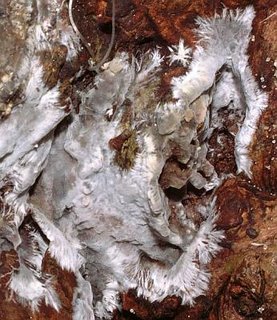Mycelium, Hyphae, Fairy ring
When fungal spores germinate, they develop into microscopical, cylindric, elongated structures with cross walls: the hyphae. In most cases the hyphae join up and form very fine filaments, the mycelium, a kind of felt-like web of varying density. These numerous and diffuse mycelial threads are distributed within the substrate, i.e. soil, organic litter or wood, and are able to extract nutrients and carbohydrates from this substrate.Parasitic and saprophytic fungi are able to digest organic matter externally (just outside the hyphae) and to absorb the released carbohydrates (sugar compounds etc). The mycelia of the symbioticmycorrhiza fungi are highly capable of dissolving and absorbing mineral salts from very poor soils, thus providing the plant (with which it coexists) with essential nutrients. In return the fungus receives the essential organic substances upon which it feeds, i.e. sugar compounds and starch. For this purpose the hyphae are permanently connected with the plant's rootlets through tiny socket-like structures.
Under favourable circumstances little buds appear on the mycelium, from which will grow - like apples on a tree - the sporophores (i.e. mushrooms, toadstools etc) that are able to produce the spores. The mycelia of many species may survive for many years, sometimes even for centuries. One day a huge coherent mycelium of a Honey Fungus (Armillaria lutea) was discovered: it extended over 38 acres, weighed over 100 tons and had an estimated age of ± 1500 years.
If the mycelial web grows outward from a centre in all directions with a more or less constant rate, the above-ground sporophores (mushrooms) will form a so-called fairy ring, its diameter increasing every year. In time the old mycelium dies, again from the centre outward. The oldest known fairy ring is a kilometre wide and ± 700 years old. Very famous are the 300 years old and 100 metres wide fairy rings of the Fairy Ring Toadstool (Marasmius oreades) on the hills surrounding Stonehenge.
Labels: Fairy ring, Hyphae, Mycelium







